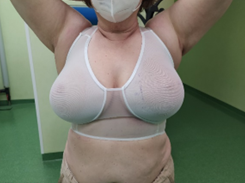Use of Chabner XRT® radiation bra in large-breasted patients: a preliminary experience
PO-2280
Abstract
Use of Chabner XRT® radiation bra in large-breasted patients: a preliminary experience
Authors: maika di Benedetto1, Francesca Cucciarelli1, Lorenzo Vagnoni1, Eleonora Arena1, Cristina Mariucci1, Clelia Di Carlo1, Elena Galofaro1, Mohamed Vincenzo Agbaje Olufemi1, Valeria Panni1, Marco Parisotto2, Lisa Vicenzi1, Francesco Fenu1, Marco Valenti2, Giovanna Mantello1
1Azienda Ospedaliero Universitaria delle Marche, Radiotherapy Department, Ancona, Italy; 2Azienda Ospedaliero Universitaria delle Marche, Medical Physics, Ancona, Italy
Show Affiliations
Hide Affiliations
Purpose or Objective
Despite modern techniques, large pendulous breasts often cause problems in the simulation, planning, and treatment during radiotherapy (RT) of breast cancer patients (pts) after conservative surgery, including increased skin toxicity and incidental lung and cardiac doses. We report our experience with pts with large pendulous breasts treated with a Bra during RT and the impact on treatment reproducibility, acute skin toxicity, and pulmonary and cardiac dosimetry.
Material and Methods
From August 2020 to April 2022, twelve large-breasted pts (6 right and 6 left) underwent RT after breast conserving surgery. During simulation, pts put on Chabner XRT® Radiation Bra (Bra) custom-fit adapted to ensure that the breast tissue was contained entirely within the Bra cup. The shoulder straps have been adjusted and all points of Velcro® attachment have been indexed. Thermoplastic polyurethane windows allowed visibility of skin and bony landmarks essential for repeatable position. Two mm slices-Computed Tomography scan was acquired with and without Bra in supine position on a breast board immobilization device, with both arms raised above the head and extended from the mandibular angle to the diaphragm. RT was performed using 3-dimentional RT (3DCRT) in 6 pts and volumetric modulated Arc therapy (VMAT) in 6 pts. In 4 pts with unfavorable anatomy or comorbidities deep inspiration breath hold (DIBH) technique was used. All pts received 40,05 Gy in 15 fractions to whole breast (WB) with a sequential or simultaneous integrated boost in hypofractionated regime; only one pt underwent RT to WB plus regional lymph nodes in conventional fractionation due to an autoimmune disease. Selected dose constraints were: Dmean ≤ 5Gy, V8Gy ≤ 30%, D5% ≤ 16 Gy to the heart; V16Gy ≤ 20%, V8Gy ≤ 35%, V4Gy ≤ 50% to the ipsilateral lung. Toxicities were evaluated using Common Terminology Criteria of Adverse Events (CTCAE) version 5.0 scale.

Results
3DCRT or VMAT technique planning and Bra device allowed dose homogeneity, less lateral breast displacement with less heart and lung involvement, compared to plan without Bra. The dosimetric parameters were in all pts: heart V8Gy ≤ 8%, D5% ≤10 Gy Dmean ≤ 4 Gy; ipsilateral lung V16Gy ≤ 19%, V8Gy ≤ 33%, V4Gy ≤ 44%. Daily IGRT showed optimal reproducibility. RT was well tolerated: all pts presented Grade 1 fatigue, disappeared after 1 month of follow-up; 9 pts Grade 1 and 3 pts Grade 2 erythema.
Conclusion
In our preliminary experience, the use of Bra improved simulation, planning, daily reproducibility, and cosmetic outcome. This device application also reduced the dose to the heart and ipsilateral lung. More cases are needed to confirm the effectiveness of the device in terms of treatment reproducibility and improvement in dosimetric parameters.